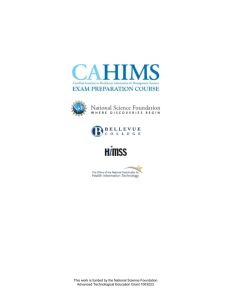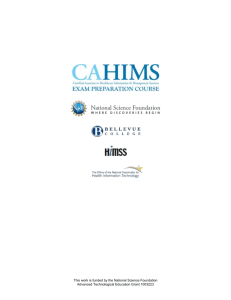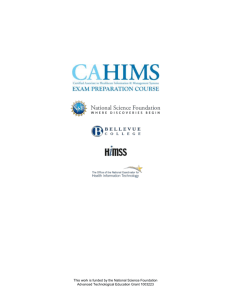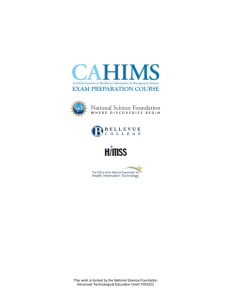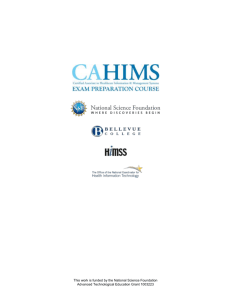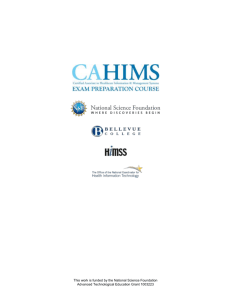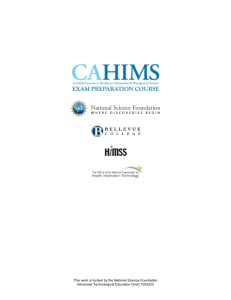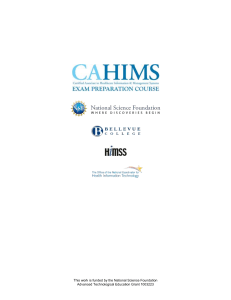3.4-Assessment-Key
advertisement
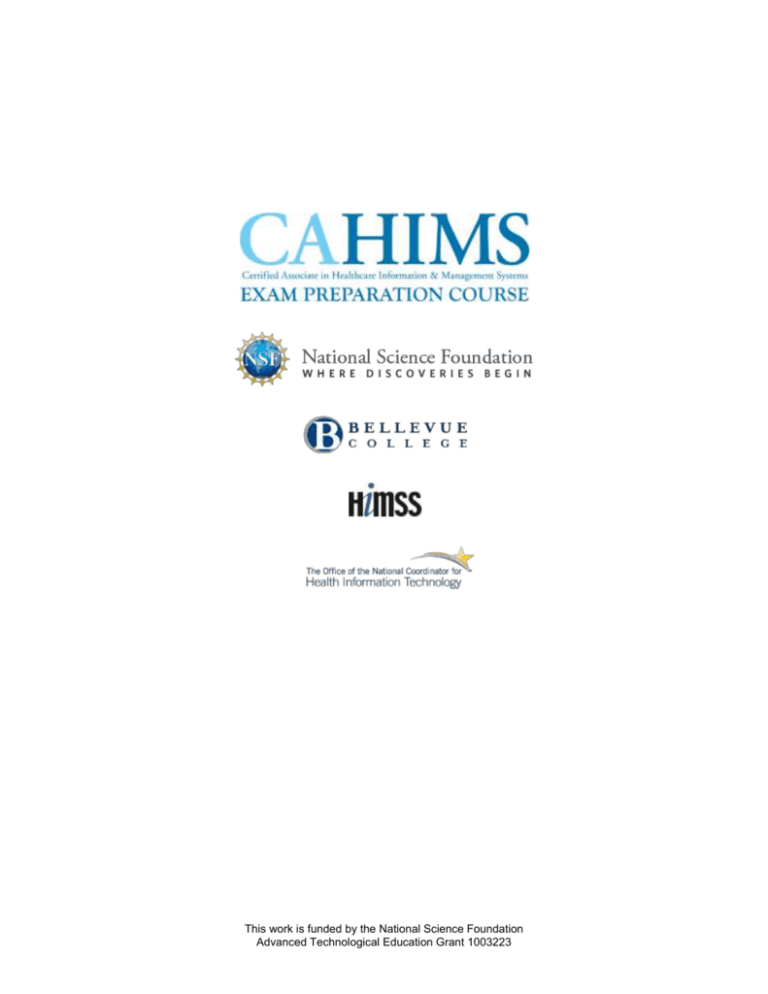
This work is funded by the National Science Foundation Advanced Technological Education Grant 1003223 The CAHIMS Exam Preparation Course and the CAHIMS exam are the result of collaboration between the Life Science Informatics Center at Bellevue College and the Healthcare Information and Management Systems Society (HIMSS). Significant content found in the CAHIMS Exam Preparation Course stems from the Office of the National Coordinator for Health Information Technology. Creation of the CAHIMS Exam Preparation Course and the CAHIMS exam was made possible through support from the National Science Foundation (NSF). Curriculum Team: Margaret Schulte, DBA Michèle Royer, PhD Nathan Savage, MLIS This work is funded by the National Science Foundation Advanced Technological Education Grant 1003223 Section 3 - HIMS Analysis and Design Lesson 3.4 - Usability and Human Factors Assessment Questions Answer Key Lectures 3, 4 & 5 1. Which of the following is NOT a dimension that differentiates the discipline human factors from human computer interaction (HCI)? *a. Human factors places an emphasis on innovative design b. Human factors has a focus on the study of devices and technology c. Safety issues are a central concern in human factors d. Study of the workplace is central to human factors analysis Answer: a Lecture/Slide: 3/4 2. Which of the following is a commonality between human factors and human computer interaction (HCI)? a. Both emphasize innovative design and technology b. Both share a main focus of patient safety issues *c. Both emphasize a user-centered approach to design d. Both share the same history and academic societies Answer: c Lecture/Slide: 3/5 3. Which of the following is a focus of human computer interaction? *a. Cutting edge design and technology b. Patient safety issues c. Range of systems and technology d. A and B e. All of the above Answer: a Lecture/Slide: 3/4 4. All of the following are reasons why human factors have become increasingly important EXCEPT for which one? a. Increase in use of technology by diverse users This work is funded by the National Science Foundation Advanced Technological Education Grant 1003223 Page 1 b. A growing awareness of safety concerns c. The cost to humans in technology error d. Increase in need for quality control *e. All of the above are reasons Answer: e Lecture/Slide: 3/6-7 5. All of the following are subdisciplines of human factors/ergonomics EXCEPT for which one? a. Organizational Ergonomics b. Physical Ergonomics *c. System-Centered Ergonomics d. Cognitive Ergonomics Answer: c Lecture/Slide: 3/14 6. Designing the nurse workplace station to facilitate and support usability is an example of which ergonomic domain? a. Organizational *b. Physical c. Cognitive d. a and b e. All of the above Answer: b Lecture/Slide: 3/15 7. Designing the work schedule for healthcare workers to ensure that they receive adequate breaks is an example of which ergonomic domain? *a. Organizational b. Physical c. Cognitive d. a and b e. All of the above Answer: a Lecture/Slide: 3/16 This work is funded by the National Science Foundation Advanced Technological Education Grant 1003223 Page 2 8. Designing a computer software program to enhance the ability of physicians to make decisions is an example of which ergonomic domain? a. Organizational b. Physical *c. Cognitive d. a and b e. All of the above Answer: c Lecture/Slide: 3/17 9. Selective attention is characterized by an ability to do which of the following? a. Make the right decision in the right context b. Reduce errors by concentrating on the correct feature set *c. Ignore extraneous information and focus on relevant inputs d. Reduce visual noise in one channel while concentrating one’s efforts on an auditory channel Answer: c Lecture/Slide: 3/20 10. Which of the following factors has been shown to adversely affect performance? a. An upcoming deadline b. An increase in workload c. An increase is compensation *d. a and b e. All of the above Answer: d Lecture/Slide: 3/20 11. Which selective attention factor refers to the fact that we tend to sample the world where we expect to find information? a. Salience *b. Expectancy c. Effort d. Cognition This work is funded by the National Science Foundation Advanced Technological Education Grant 1003223 Page 3 Answer: b Lecture/Slide: 3/22 12. Which selective attention factor refers to the fact that events that are relevant to us tend to capture our attention? *a. Salience b. Expectancy c. Effort d. Cognition Answer: a Lecture/Slide: 3/22 13. Which selective attention factor refers to the fact that an extreme effort to accomplish a task may inhibit attention? a. Salience b. Expectancy *c. Effort d. Cognition Answer: c Lecture/Slide: 3/22 14. The following quote “When human error is viewed as a cause rather than a consequence, it serves as a cloak for our ignorance,” suggests which of the following? a. Posthoc evaluations of error are affected by hindsight bias that masks the dilemmas, uncertainties, and demands of factors. b. Humans are essentially blameless when you closely scrutinize the latent conditions c. Active errors, which are human-based, are qualitatively different from latent errors, which are computer-based. *d. Human error often reveals a long chain of events and conditions that greatly increase the likelihood of human error e. All of the above Answer: d Lecture/Slide: 4/4 This work is funded by the National Science Foundation Advanced Technological Education Grant 1003223 Page 4 15. Which of the following is NOT an example of a slip? a. Nurse neglects to change the dose of medication as requested by the resident *b. Physician mistakenly dismisses early signs of congestive heart failure as asthma due to allergies c. Pharmacist mixes up medication labels causing the wrong medication to be given to a patient d. Nurse prepares an infusion pump drip and executes every step except pressing the start key to initiate the process e. All of the above are examples of slips. Answer: b Lecture/Slides: 4/11-16 16. According to James Reason, which of the following conditions refers to the enduring systemic problems that lay dormant for some time and combine with other system problems to weaken the systems defenses and make errors possible? a. Active conditions *b. Latent conditions c. Cognitive conditions d. Human conditions Answer: b Lecture/Slide: 4/6 17. All of the following are characteristic of the human interface dimension as it applies to the analysis of adverse events EXCEPT for which one? a. Medical Devices b. Equipment Location c. Paper/electronic Charts d. Distractions *e. All of the above are characteristics Answer: e Lecture/Slide: 4/18 This work is funded by the National Science Foundation Advanced Technological Education Grant 1003223 Page 5 18. In analyzing the time course of error, a “near miss” refers to: a. An adverse event in which the damage is limited *b. An error was committed, but was corrected before damage resulted c. A minor problem resulting from normal routine work that resulted in minor damage d. An error that can be viewed as distributed in the social world and thereby diffused before tragedy strikes Answer: b Lecture/Slide: 4/20 19. Which of the following is a reason why stress and burnout can have a negative impact on performance with respect to the effect of heavy workload on performance? a. It can lead to frustration and negative attitudes towards one job. b. Nurses will often fail to administer the appropriate medication dosages c. It depletes ones attentional resources and leaves an employee with insufficient time to perform tasks safely. *d. It results in reduced physical and cognitive resources to perform adequately e. It invariably results in numerous adverse events Answer: d Lecture/Slide: 5/2 20. Which of the following represent limitations in the use of mobile health devices with patients a. They are surprisingly heavy for older adults b. The small screen diminishes visibility and interactivity c. Complex hierarchical menu systems makes navigation challenging *d. b and c e. All of the above Answer: d Lecture/Slide: 5/10 This work is funded by the National Science Foundation Advanced Technological Education Grant 1003223 Page 6 Lecture 6 21. Which of the following best characterizes the importance of usability in the implementation of electronic health records? a. It contributes to the science of the field b. It helps clinicians do their work better c. It means users will have a positive attitude to implementation of electronic health records d. It can help prevent medical errors *e. All of the above Answer: e Lecture(s)/Slide(s): 6/All 22. All of the following are reasons why implementation of EHRs in the healthcare setting is a challenge EXCEPT for which one? a. Learned helplessness of clinicians b. Political and power struggle of administration c. Lack of clinician input at design *d. The socially distributed nature of the facility Answer: d Lecture(s)/Slide(s): 6/9 23. Which of the following is a factor that affects the usability of an EHR system in a healthcare facility? a. Screen display b. Software design c. Workflow d. a and b *e. All of the above Answer: e Lecture(s)/Slide(s): 6/All This work is funded by the National Science Foundation Advanced Technological Education Grant 1003223 Page 7
